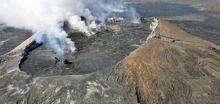May 27, 2011 report
New explanation for Hawaiian hot spot

(PhysOrg.com) -- Scientists in the US have suggested that volcanic activity in Hawaii could be fed by a giant hot rock pool 1,000 kilometers west of the islands and in the Earth’s mantle, rather than being fed by a hot plume of magma as previously thought.
Hawaii’s volcanoes have puzzled scientists for decades because the islands lie in the middle of a tectonic plate rather than at the edge, where volcanic activity would be expected. Until now the prevailing theory has been the mantle plume theory, which suggested the volcanism was fed by a hot plume rising from the Earth’s mantle, but so far efforts to detect a hot plume seismically have remained inconclusive.
The mantle plume theory was developed by US scientist Jason Morgan in 1971 and suggests the tectonic plate is sliding above a stationary plume of molten rock lying deep within the mantle, with upwellings of lava forming undersea volcanoes that eventually grew upwards to become islands. As the tectonic plate continued to move the volcanoes were extinguished and some of the islands eroded and dropped below sea level. The result was the Hawaiian-Emperor seamount chain, which stretches from the Aleutian Trench in the northwest to the present-day Hawaiian islands in the southeast.
The new research, by a team led by seismologist Dr Robert van der Hilst of the Massachusetts Institute of Technology (MIT) imaged the scattering of seismic waves from discontinuities in the mantle to try to identify plumes and other subterranean structures. Discontinuities are formed when the rocks in the mantle are squeezed together at such high pressures that they abruptly reorganize themselves. They included data from almost 170,000 reflected seismic signals along with seismic data from around 4,800 earthquakes in the Pacific region.
The next step in the research was to use computer models of the behavior of a variety of minerals at different temperatures and pressures to predict the temperature of the regions beneath the Earth’s surface that reflect the seismic waves.
The results suggested a shallow 800-to 2,000-kilometer-wide “thermal anomaly” exists near the top of the lower mantle around 720 kilometers beneath the surface to the west of Hawaii. This suggests that the mantle plume theory might be wrong, since the findings do not support hot material rising as a narrow vertical plume.
According to van der Hilst, the current volcanic activity might be fuelled instead by molten rocks bubbling upwards from the eastern edge of the pool of trapped materials “like a lava lamp” rather than a mantle plume.
Other scientists have some misgivings, with Thorne Lay of the University of California pointing out that some of the data selected for the analysis were not clean enough since 170,000 good quality waveforms do not exist, and using noisy data could have introduced errors.
Dr van der Hilst agreed the team used data other seismologists could discard as too noisy, but said they were able to “exploit the noise reduction of very large data sets.” He also said that carefully selecting data could produce bias in the results.
The paper was published in the journal Science on May 27.
More information: Seismic Imaging of Transition Zone Discontinuities Suggests Hot Mantle West of Hawaii, Science 27 May 2011: Vol. 332 no. 6033 pp. 1068-1071 DOI: 10.1126/science.1202731
ABSTRACT
The Hawaiian hotspot is often attributed to hot material rising from depth in the mantle, but efforts to detect a thermal plume seismically have been inconclusive. To investigate pertinent thermal anomalies, we imaged with inverse scattering of SS waves the depths to seismic discontinuities below the Central Pacific, which we explain with olivine and garnet transitions in a pyrolitic mantle. The presence of an 800- to 2000-kilometer-wide thermal anomaly (ΔTmax ~300 to 400 kelvin) deep in the transition zone west of Hawaii suggests that hot material does not rise from the lower mantle through a narrow vertical plume but accumulates near the base of the transition zone before being entrained in flow toward Hawaii and, perhaps, other islands. This implies that geochemical trends in Hawaiian lavas cannot constrain lower mantle domains directly.
© 2010 PhysOrg.com


















